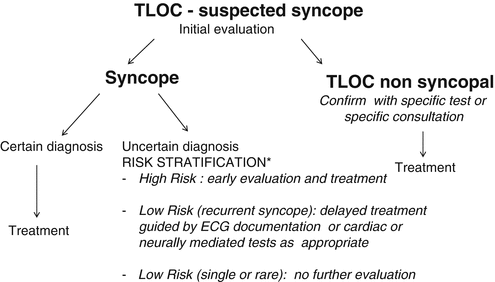Fig. 2.1
Context of transient loss of consciousness. SCD sudden cardiac death, TLOC transient loss of consciousness
Table 2.1
Conditions incorrectly diagnosed as syncope
Disorders with partial or complete LOC (without global cerebral hypoperfusion) |
Epilepsy |
Metabolic disorders including hypoglycemia, hypoxia, hyperventilation with hypocapnia |
Intoxication |
Vertebrobasilar TIA |
Disorders without impairment of consciousness |
Cataplexy |
Drop attacks |
Falls |
Functional (psychogenic pseudosyncope) |
TIA of carotid origin |
Table 2.2
Classification of syncope
Neurally mediated syncope |
Vasovagal cause |
Mediated by emotional distress (fear, pain, instrumentation blood phobia) |
Orthostatic stress |
Situational |
Sneeze, cough |
Gastrointestinal stimulation (defecation, abdominal pain, swallowing) |
After micturition |
After exercise |
Postprandial |
Others |
Carotid sinus syncope |
Forms without apparent triggers or atypical presentation |
Orthostatic hypotension syncope |
Primary autonomic failure |
Pure autonomic failure, multiple atrophy, Parkinson disease with autonomic failure |
Lewy body dementia |
Secondary autonomic failure |
Diabetes, amyloidosis, uremia, spinal injuries |
Drug-induced orthostatic hypotension |
Alcohol, vasodilators, diuretics, antidepressants |
Volume depletion |
Hemorrhage, diarrhea, vomiting, etc |
Cardiovascular syncope |
Arrhythmia as primary cause |
Bradycardia: sinus node dysfunction, AV conduction system disease, implanted device dysfunction |
Tachycardia: supraventricular, ventricular |
Drug-induced bradycardia and arrhythmias |
Structural disease |
Cardiac: valvular diseases, AMI, hypertrophic cardiomyopathy, etc |
Others: acute aortic dissection, pulmonary hypertension, pulmonary embolus |
This syncope often raises diagnostic and therapeutic problems which is proved by the diversity of the pathways followed by patients attending the ED. Indeed, data from the literature [4–7] reveal that these patients may be hospitalized in cardiology, neurology, pediatric, geriatric, internal medicine, and orthopedic wards. These patients then undergo, often inappropriately, several instrumental examinations that are costly and have a low diagnostic yield. The result is that hospitalization is prolonged and healthcare costs rise, while a correct diagnosis of the cause of syncope fails to be reached in a high percentage of cases. As the risk of malpractice suits is high in this field, ED physicians often adopt a strategy of “self-defense,” which results in an increase of the number of hospitalizations and inappropriate instrumental investigations. Thus, the current management of syncope displays little diagnostic efficacy and considerable economic inefficiency.
The factors underlying these disappointing results can be summed up as follows: insufficient competence and attention on the part of physicians with regard to the differential diagnosis of TLOC, owing to the difficulty of tackling this problem in a multidisciplinary manner; a “defensive” stance prompted by the possible legal implications of a wrong diagnosis; and, in various healthcare institutions, the lack of diagnostic and therapeutic facilities specialized in the management of syncope patients [11, 12].
2.2.2 The Recommended Management of Syncope in the ED
Most of the direct cost of syncope is attributable to hospitalization. A proper diagnostic evaluation and prognostic stratification of syncope in the ED should limit hospitalization to patients suffering from heart disease, serious neurological diseases, or severe secondary traumas.
In 2009 the European Society of Cardiology developed guidelines on the management of syncope [10]. This document defined what has become the current standard for the management of patients with TLOC and the most valuable diagnostic pathway, and gave recommendations on indications and interpretation of diagnostic tests with indications for hospitalization and treatment.
According to the guidelines, the cornerstone in syncope management in the ED is the initial clinical evaluation, i.e., history, physical examination, recumbent and orthostatic blood pressure measurement, and electrocardiogram (ECG).
Patients should be interrogated about:
The circumstances (position and activity of the patient, presence of predisposing factors) and symptoms (nausea, dizziness, palpitations) occurring just before the attack
Manner of fall (slumping or kneeling over), duration, and whether movements were present during LOC (if witnessed)
Number, frequency of spells, and age at first episode
Family history of cardiac disease or sudden death, neurological history, metabolic disorders
Consultation by a cardiologist is indicated when a cardiac cause is suspected or ascertained, particularly in cases of:
Presence of definite heart disease, family history of sudden death, or channelopathy
Syncope during exertion or in supine position
Sudden onset of palpitation prior to the syncope
ECG abnormalities such as intraventricular delay with QRS duration >120 ms, Mobitz II second-degree atrioventricular block, sinoatrial pauses >3 s, nonsustained ventricular tachycardia, preexcitation, long or short QT intervals, Brugada pattern, negative precordial T waves suggestive of right ventricular dysplasia, Q waves suggesting previous myocardial infarction, pacemaker/implantable cardioverter-defibrillator malfunction.
Neurological consultation (Fig. 2.2) is indicated for a nonsyncopal TLOC cause (epilepsy, transient ischemic attack, subclavian steal syndrome, psychogenic pseudosyncope), especially in cases of:


Fig. 2.2
Diagnostic flowchart of patients with suspected T-LOC.*May require laboratory investigations. ECG electrocardiographic, TLOC transient loss of consciousness
Presence of aura before the event
Tonic-clonic movements coinciding with the onset of LOC (and not some seconds later) or hemilateral
Clear automatisms or tongue biting
Prolonged confusion after the episode
Family history of seizures, sleepiness or headache after the event
Specific tests such as neurological investigations or blood tests are only indicated for a suspicion of nonsyncopal TLOC.
This strategy requires adequate clinical competence on the part of all of the physicians involved in the management of these patients. Table 2.3 presents the diagnostic criteria that permit a diagnosis of the causes of syncope in the ED by means of initial evaluation, and Table 2.4 lists the clinical features that suggest a diagnosis.
Table 2.3
Diagnostic criteria of causes of syncope with initial evaluation
Vasovagal syncope is diagnosed if syncope is precipitated by emotional distress or orthostatic stress, and is associated with typical prodrome |
Situational syncope is diagnosed if syncope occurs during or immediately after specific triggers listed in Table 2.2 |
Orthostatic syncope is diagnosed when it occurs after standing up and there is documentation of OH

Full access? Get Clinical Tree
 Get Clinical Tree app for offline access
Get Clinical Tree app for offline access

|




